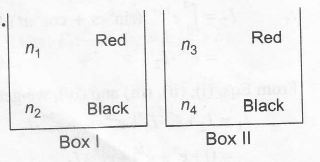Answer:
Option A,B
Explanation:

Let A= Drawing red ball
$\therefore$ $ P(A)=P(B_{1}).P(A/B_{1})+P(B_{2}).P(A/B_{2})$
$=\frac{1}{2}\left(\frac{n_{1}}{n_{1}+n_{2}}\right)+\frac{1}{2}\left(\frac{n_{3}}{n_{3}+n_{4}}\right)$
Given $ P(B_{2}/A)$=$\frac{1}{3}$
$\Rightarrow$ $\frac{P(B_{2}).P(B_{2}\cap A)}{P(A)}=\frac{1}{2}$
$\Rightarrow$ $ \frac{\frac{1}{2}\left(\frac{n_{3}}{n_{3}+n_{4}}\right)}{\frac{1}{2}\left(\frac{n_{1}}{n_{1}+n_{2}}\right)+\frac{1}{2}\left(\frac{n_{3}}{n_{3}+n_{4}}\right)}=\frac{1}{3}$
$\Rightarrow$ $\frac{n_{3}(n_{1}+n_{2})}{n_{1}(n_{3}+n_{4})+n_{3}(n_{1}+n_{2})}=\frac{1}{3}$
Now, check options, then clearly options (a) and (b) satisfy.